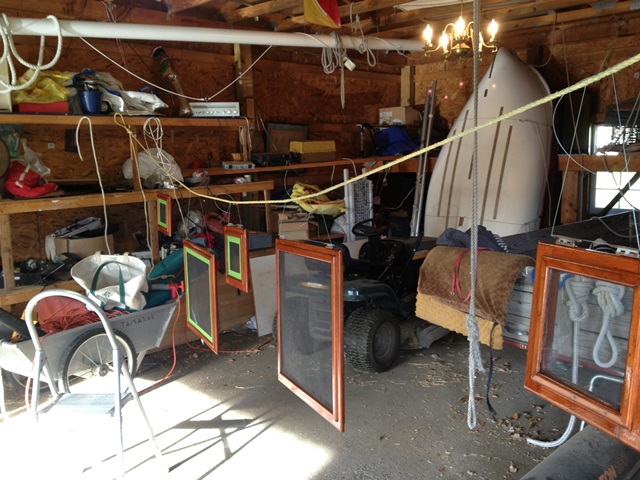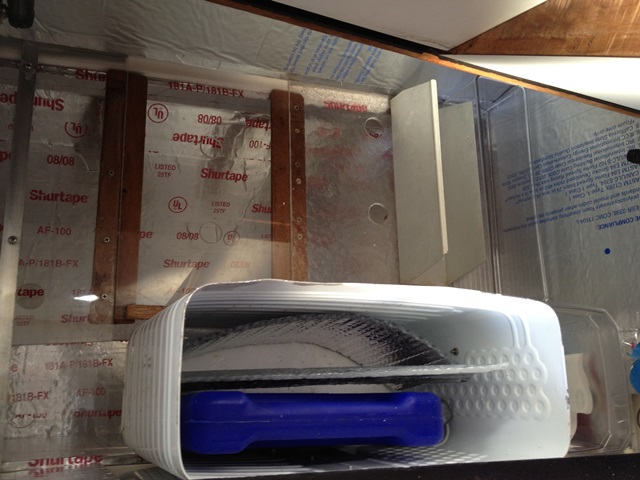| Continuation of
last year's rudder project |
These are pictures of the rudder
project I was working on. The shaft in the first picture is the rudder
stock. On the shelf the collar, Delryn ring and plate are the upper
bearing as the boat was designed. The stock is 2" in diameter, the
plate is 1/4" Not much of a bearing when you consider the loads on the
rudder when a 24,000 lbs boat is running down the face of an ocean
swell.
In the second pick you are looking at the underside of the shelf in the
first pick. The shelf is two shades of white. When coming back from the
Bahamas a year ago the steering felt sloppy. When I got to northern
Florida I found that there was a lot of rot in the shelf. Of the four
bolts attaching the metal plate in the first picture only one was in
solid wood. Last summer I spent days laying under the shelf scraping
out the rotten wood, making a Coosa board replacement and gluing it in
and putting over sized washers behind the nuts. Over this long cold
winter I thought about that 1/4" plate called a bearing and decided I
could do better. At the top of the second picture is the plate I had
made. It too is 1/4", is split in half so I could get it around the
stock without having to drop the rudder out of the boat. The halves are
joined by flanges and machine screws. The two metal plates are
separated by 7/8" of wood and fiberglass. Now I have a proper bearing
to carry the loads acting perpendicular to the stock.
At the bottom of the second picture is the steering quadrant. It is a
giant disc about 2' in diameter, cables are around it that are
connected to the steering wheel up on deck. In the background there is
a little post with a rubber bushing on it. This is a stop to prevent
the helmsman from turning the rudder too far.
The last picture is a selfie. The hydraulic ram for the autopilot and
the steering quadrant are both back in place. With them in place you
can no longer see the plate I added. It is all in a pretty small space.
By my left shoulder you can see the packing gland where the rudder
stock exits the hull to the rudder. The packing gland also serves as
the lower bearing. |
 |
 |
 |
| Below are the PlasTeak boarding ladder treads that
replace the original teak treads. The originals were showing their age. |
Below is my assembly line for refinishing the overhead
hatch screens. Since they needed to be varnished on both sides it was
more efficient to suspend them rather than lay them flat and be limited
to doing just one face at a time. |
 |
 |
| On the right is a photo of the fridge after the foil
backed foam board has been added. The R-factor of the board is
R3, which should make the fridge a little more efficient. The
plexi-glass shelf dividing the space is my design. The center
panel can be lifted out without removing the two end pieces making it
easier to get things from the bottom of the fridge. Previously it had
been two pieces requiring un;loading the top of the fridge in order to
get to things in the bottom. |  |
| No pictures for this one but I sanded out a small section of the cabin sole that had become discolored when some (1.5 gallons) distilled water leaked from its container and wicked into the edge of the sole. |
After two weeks of struggling with cabinetry built around the old water heater that was disintegrating in my hands, installing the new smaller water heater, discovering that the freshwater pump had quit, installing a new pump only to discover that the Qest fittings at the new water heater do not play well with anything but other compression fittings, learned only through trial and error, only to discover that the new pump didn't work properly, waiting for the new pump head for the old pump motor, putting the old pump with its new head back in place I now have a working freshwater system. That run-on sentence gives some idea of how I felt during what should have been a pretty straightforward job. A couple of pictures are below. |

|
 |
| At right is one of the forward head through hulls after I broke the ball valve handle off. |
 |
In getting the ball valve off the thru-hull I turned the latter, so it had to be removed and reseated. The hole below was done at the factory; not a bery careful job.

|
Below is the finished job.

|




